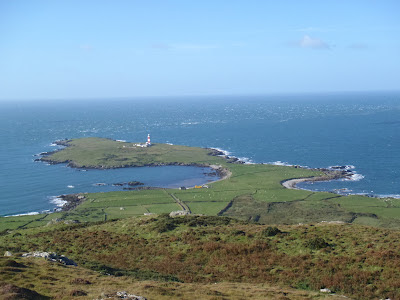The small, rugged, wind
swept island of Bardsey lies off the Llyn Peninsula in north west Wales. To the north east the island rises steeply from the
waves that crash onto the blackened rocks to a scraggy peak 167 m high. The
mountain is covered in browns, dark greens and grey of rock, bracken and gorse.
Small patches of pink heather and the last remnants of thrift cling on,
buffeted by the ever present breeze. Nestled along the western side of the mountain are the 19th century cottages and farmhouse, their grey stone or white walls overlooking lush grassy fields of the lowlands, where black cows and brilliant white sheep graze. To the
south the coast narrows, like a belt tightened around a small waist, so that
the rocky beaches either side almost meet, before blooming again into a rounded
peninsula where the red and white striped lighthouse stands proud.
 |
| Bardsey Island |
The island is renowned for
its wildlife, and is a National Nature Reserve and Site of Special Scientific
Interest. During the summer days the skies are filled with the cries of nesting
seabirds, crammed on the east side of the mountain. Whilst during the summer
nights, eerie, spooky calls of nesting manx sheatwaters take over the show.
During autumn and spring the island is ideally located on one of the main
migration routes, producing not only hundreds of the more common migrant
species but also the odd rarity. The sea around the island, with its racing
tides provides an important habitat for whales and dolphins, particularly the
Risso’s dolphin. Such is the regularity with which this species is seen,
especially during August and September that the Whale and Dolphin Conservation
Society has been conducting research on the habitat use of the dolphins around
the island since 1999.
Our week on this beautiful
wild haven started with brilliant blue skies, warm September sunshine and flat
calm seas. Wandering around the island we soaked up the laid back pace of
island life, meadow pipits and flocks of linnet tumbled over head, turnstone
noisily chattered amongst the rocks of the shoreline and the sky filled with
the cheeky calls of sleek, black, bright legged choughs. Along the shoreline mother grey seals prowl the surf, or bask in the sun keeping a sharp eye on their newborns tucked away among the rocks. The younger ones are white and fluffy, while the older pups have shed their baby fur and are now a silvery grey. Out to sea, in the
distance a shadow breaks the surface. A pod of common dolphins, shimmering as
they chase fish, leaping clear of the glittering blue.
 |
| Grey seal pup |
Sunday and the wind had
returned, bringing cloudy skies and creating white caps out to sea. The
afternoon was spent down on the shelly beach where dark brown seaweeds mark the
edge of the tide. Here a small walk in trap catches rock and meadow pipits,
along with the odd white wagtail. Affectionately known as rockits the rock
pipits are colour ringed on the island with the aim of establishing where they
go in the winter months.
That evening it started to
rain, and did not stop for 48 hours. Undeterred we trooped out, sploshing
through the puddles to settle into ancient looking stone hides and staring out
to sea. Through the rain, the sea looked a pale aquamarine. Gannets, kittiwakes
and hundreds of razorbills skim over the waves, and there through the narrowed
circle of a telescope eye piece, a small pod of Risso’s dolphin. Their tall
dorsal fins rise slowly from the gentle waves, followed briefly by a heavily
scarred back.
Wednesday dawned with the
clouds being pushed and pulled through a pale blue sky. Rain still threatened
but never really returned with any gusto. Although still slightly breezy, mist
nets were opened in more sheltered areas of the island. Amongst the blackcaps,
goldcrest and chaffinch, a treat – the subtle beauty of a spotted flycatcher,
one of five on the island at the time.
 |
| Spotted flycatcher |
By afternoon the sun was
finally winning its battle with the clouds, spreading warm golden light on a
beautiful little bunting that briefly perched at the top of a pine tree. This
special bird is a scarce visitor to the British Isles with on average 29 records reported each year.
 |
| A stunning little bunting |
The sunny, windy conditions
continued over the last few days of our stay. Goldcrest continued to fill
our nets, whilst during our wanderings around the island we witnessed first
hand the tussle and tumble of the natural world. The peace of a feeding flock
of rock pipits erupts as a merlin comes crashing through. The flock bursts into
the air, the merlin in hot pursuit, twisting and turning in tight circles
before disappearing over a ridge. A few minutes later and the rock pipit is
hiding under the wheels of a tractor, the merlin perched on top perhaps cursing the one that got away.
 |
| The chase is on between a merlin and a rock pipit... |
Time on the island seems
more dictated by seasons than by clocks or calendars; the days merge into one
continual flow of changing light and weather. As our week draws to an end, it
is time to return to the hustle and bustle of mainland life, while the island
and its inhabitants remain in their natural cocoon of this wild landscape.






No comments:
Post a Comment